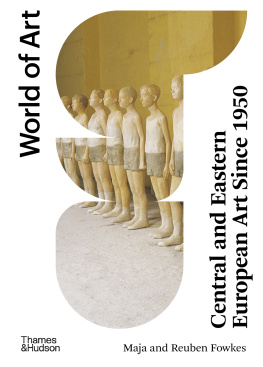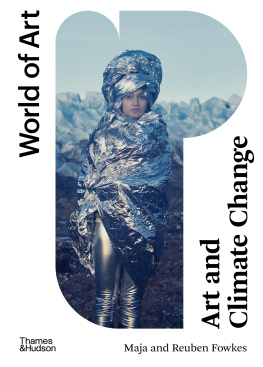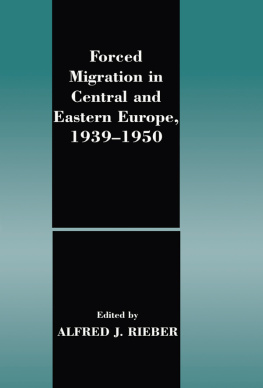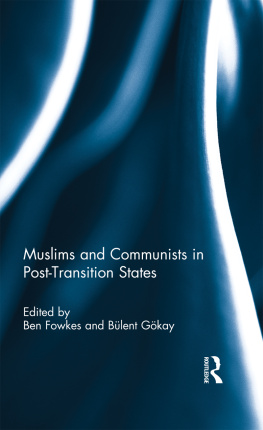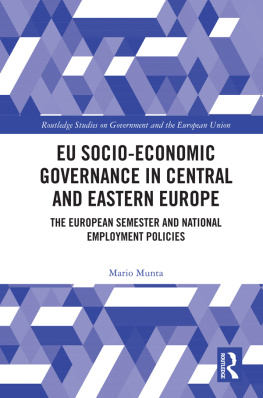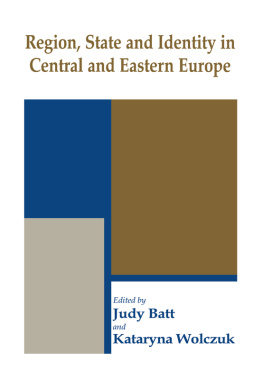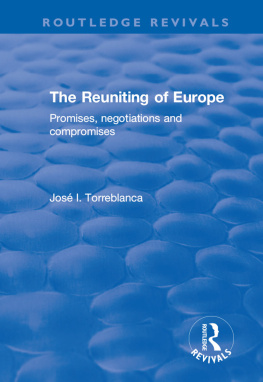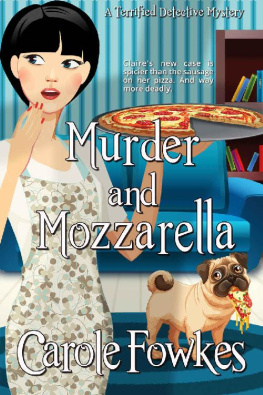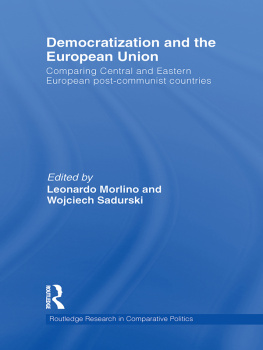Maja Fowkes - Central and Eastern European Art Since 1950
Here you can read online Maja Fowkes - Central and Eastern European Art Since 1950 full text of the book (entire story) in english for free. Download pdf and epub, get meaning, cover and reviews about this ebook. year: 2020, publisher: Thames & Hudson, genre: Art. Description of the work, (preface) as well as reviews are available. Best literature library LitArk.com created for fans of good reading and offers a wide selection of genres:
Romance novel
Science fiction
Adventure
Detective
Science
History
Home and family
Prose
Art
Politics
Computer
Non-fiction
Religion
Business
Children
Humor
Choose a favorite category and find really read worthwhile books. Enjoy immersion in the world of imagination, feel the emotions of the characters or learn something new for yourself, make an fascinating discovery.
- Book:Central and Eastern European Art Since 1950
- Author:
- Publisher:Thames & Hudson
- Genre:
- Year:2020
- Rating:4 / 5
- Favourites:Add to favourites
- Your mark:
- 80
- 1
- 2
- 3
- 4
- 5
Central and Eastern European Art Since 1950: summary, description and annotation
We offer to read an annotation, description, summary or preface (depends on what the author of the book "Central and Eastern European Art Since 1950" wrote himself). If you haven't found the necessary information about the book — write in the comments, we will try to find it.
Central and Eastern European Art Since 1950 — read online for free the complete book (whole text) full work
Below is the text of the book, divided by pages. System saving the place of the last page read, allows you to conveniently read the book "Central and Eastern European Art Since 1950" online for free, without having to search again every time where you left off. Put a bookmark, and you can go to the page where you finished reading at any time.
Font size:
Interval:
Bookmark:



Zorka Sglov, Hay-Straw, 1969.

About the Author
Maja and Reuben Fowkes are curators, critics and art historians specializing in Eastern European art history and contemporary art and ecology. They have lectured widely and are co-directors of the Translocal Institute for Contemporary Art, a centre for transnational research into Eastern European art and ecology, and they head the Post-Socialist Art Centre (PACT) at the Institute of Advanced Studies, University College London. Maja Fowkes is the author of The Green Bloc: Neo-avant-garde Art and Ecology under Socialism (2015). Their publications on Eastern European art include two special issues of the journal Third Text, on Socialist Eastern Europe and Actually Existing Artworlds under Socialism.

Jaro Varga, I Found It Somewhere, but I Cannot Find It, 2018.
The art histories of Central and Eastern Europe are interlaced with dissonant voices, conflicting tendencies and rival proclamations that derive their distinctiveness from exceptional local conditions. This observation is tempered when the lens is fine-tuned to particular artworks and singular art practices, or the focus of inquiry widened to reveal a web of connecting threads and common attitudes. Artists across the region have shared an astute engagement with the intellectual streams of the day, held vivid debates in circles of confidants and carried on ardent communication across disciplinary and geographical boundaries. Commonality could also be detected in a widespread openness towards non-institutionalized forms of activity, a predilection for collective work and resourcefulness in finding solutions and spaces for the realization of ideas. The art scenes of the region have existed in a productive tension with mainstream society, rendering them both receptive to demands for the social usefulness of art and insistent on maintaining an autonomous position. Living under communist rule inculcated suspicion of all authorities and elicited initial reserve towards extrinsic pressures, generating a critical, sceptical and subversive artistic stance that extended into post-communist times.
The geographies of the eastern half of the European continent have been more unstable than many other parts of the world. Dramatic territorial shifts caused by the redrawing of borders in the wake of the Second World War, the formation and disintegration of states, and the rise and fall of political blocs have been accompanied by an incessant regrouping of animosities and alliances. Accepting the capriciousness of territorial determinants, this account deals primarily with the socialist countries of Poland, Czechoslovakia, Hungary and Yugoslavia and their post-communist successors, periodically extending its coverage to East Germany and Romania, as well as to the Baltics and the rest of the Balkans. This geographical scope reflects also the state of research into the art history of particular countries and periods, as well as ongoing processes of integration into comparative regional narratives. Central and Eastern European art is therefore approached as an inclusive and capacious category that accommodates a range of geopolitical and historical positions, from viewing affiliation with the former Eastern Bloc and the socialist past as the determining factor to connecting with deeper cultural trajectories of Central Europe.
In contrast to the complexity of its geographies, the timescale of Central and Eastern European art is marked by less ambiguous historical watersheds. The onset of communist rule, which by the early 1950s had brought to the art of the region a short-lived stylistic unison, albeit with enduring institutional consequences, denoted a formative moment in post-war art history. The long period of actually existing socialism that followed was punctuated by political upheavals that had dramatic repercussions for artistic life across the Eastern Bloc, notably Soviet military intervention in Hungary in 1956 and Czechoslovakia in 1968, as well as the rise of the Solidarity movement and imposition of martial law in Poland in 1981. The fall of communism had a profound impact on Central and Eastern European art that can be understood today not so much in terms of a putative return to the international fold, but rather for the constitutive role of artists from the region in the emergence of a decentred global art world. Furthermore, it is important to note that the epistemologies of national art histories and comparative accounts have also been shaped in the decades since 1989 through critical reassessment of the artistic legacies of the socialist period and contemporary reflections on the artistic identity of the region.
Rather than foregrounding the impact of political histories on Central and Eastern European art, precedence in this account is given to singular art practices and outstanding artworks, situating them in proximity to the movements, styles, phenomena and events that have shaped the art scenes of the region since the 1950s. In other words, although the social and political scaffolding is provided, artworks are intentionally not made subservient to larger ideological constructs but considered instead in terms of their distinctive place in art history. Particular attention is devoted to those artists who have achieved the most recognizable careers, as reflected in their standing within national and global art histories, inclusion in museum collections and relevance to contemporary concerns. This account is biased towards experimental art practices that, prior to 1989, often developed in tension with officially promoted agendas, as well as to those contemporary approaches that partake in the artistic exchanges of the global art scene. For purposes of nuance, coverage is also occasionally extended to practices that had a more ambivalent position between national culture and the international arena, or that emerged at the intersection of official and unofficial domains, yet still subtly trimmed the art historical fabric of their country.
The highs and lows of political ideology pale in significance when compared with the impact that systemic transformation of the institutional terrain had on Central and Eastern European art worlds. Fundamental changes were introduced at the beginning of the period discussed here, with the imposition of the Soviet model of administrative centralization and Party control of exhibition spaces, art criticism and educational methods, efficiently implemented through funding mechanisms, jury committees and the regulation of artist unions. This restructuring decisively influenced the narrative of regional art histories, forcing experimental artists to seek alternative routes, formats and platforms, a strategy that was likewise adopted by art critics. Socialist art structures and attitudes have also proved remarkably resistant to reform even after the passing of the ideology they were built to serve. In the decades since the demise of the communist system a gradual reordering of the institutional landscape has taken place under the influence of neoliberal globalization. This entailed the building of new art infrastructures and the founding of regional collections, as well as the opening of art scenes to market forces, accompanied by new forms of artistic precarity. The ethical dilemmas and politically motivated decisions over whether to exhibit in particular spaces or work with certain galleries remains a live issue for many artists in the region. This account therefore includes a necessary discussion of the changing contours of art-world structures in particular localities.
Next pageFont size:
Interval:
Bookmark:
Similar books «Central and Eastern European Art Since 1950»
Look at similar books to Central and Eastern European Art Since 1950. We have selected literature similar in name and meaning in the hope of providing readers with more options to find new, interesting, not yet read works.
Discussion, reviews of the book Central and Eastern European Art Since 1950 and just readers' own opinions. Leave your comments, write what you think about the work, its meaning or the main characters. Specify what exactly you liked and what you didn't like, and why you think so.

